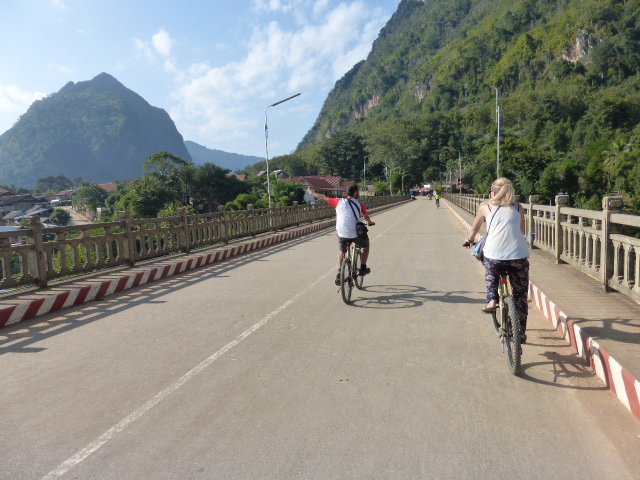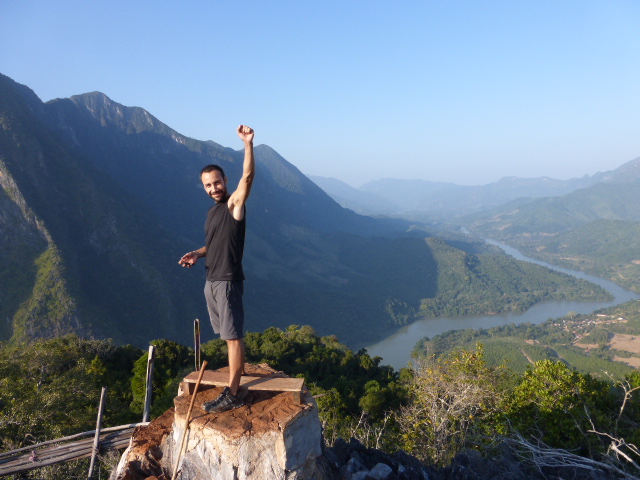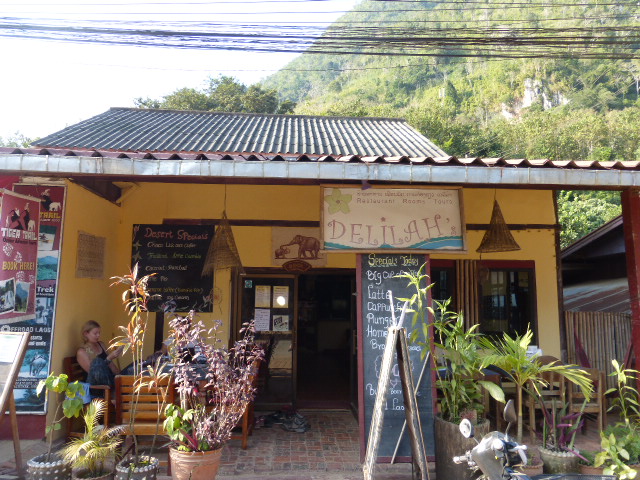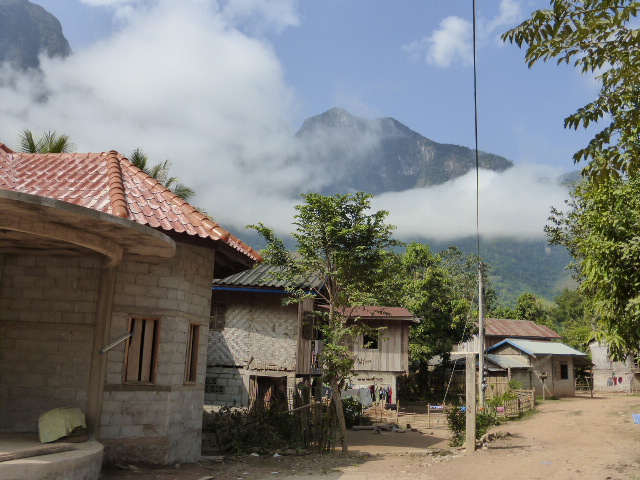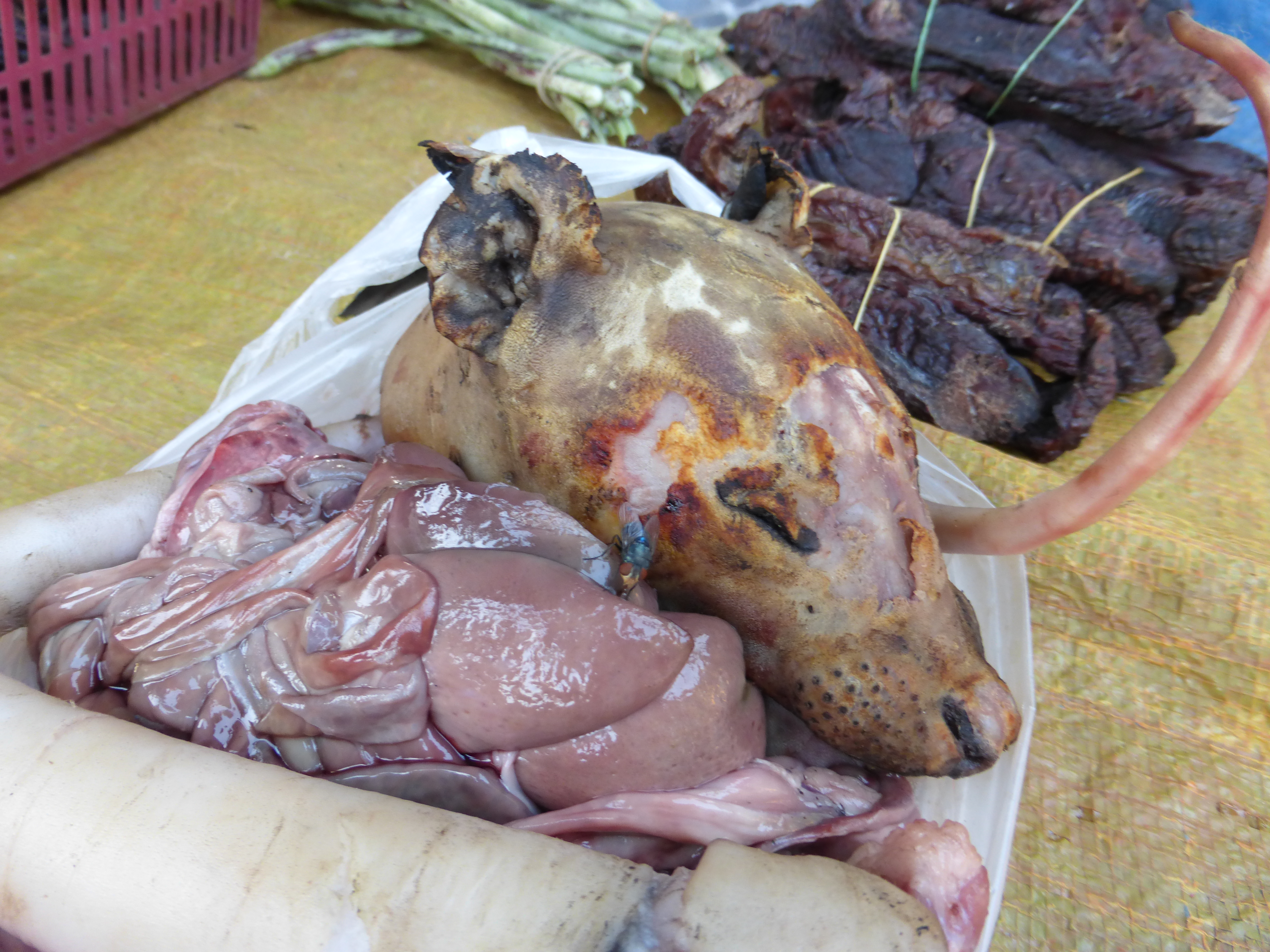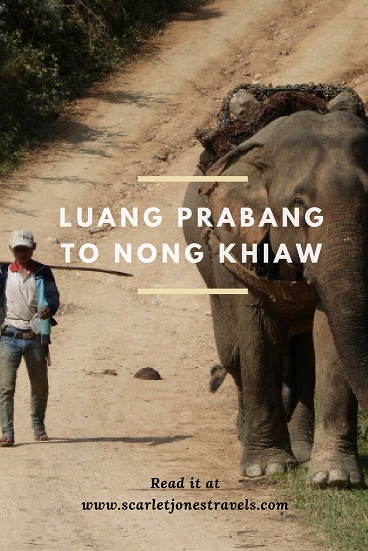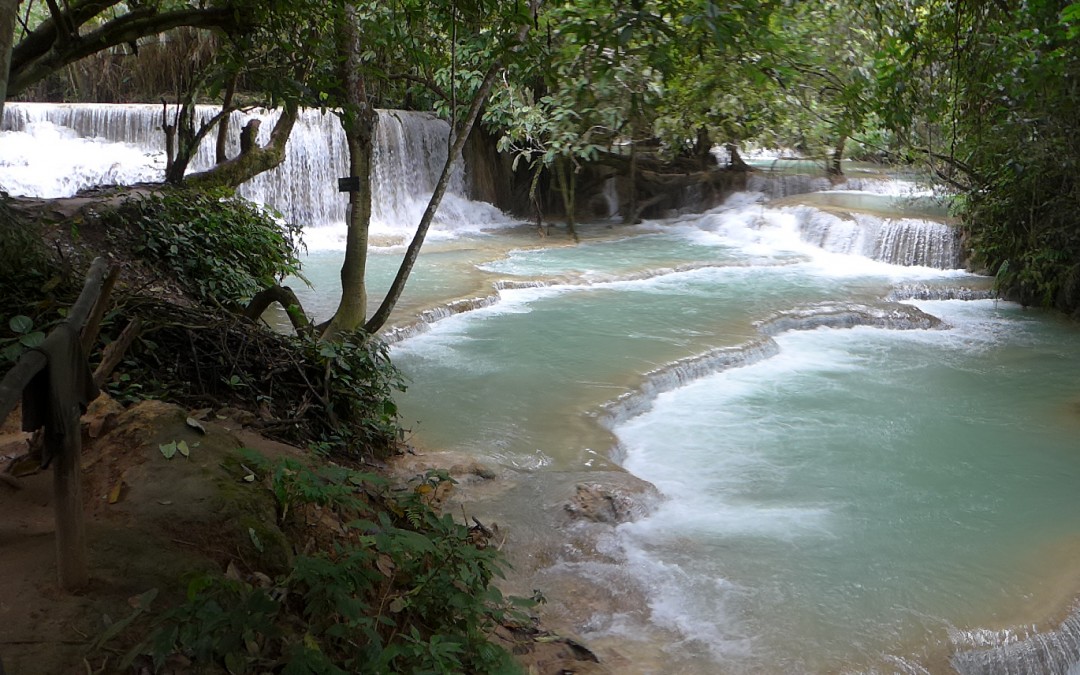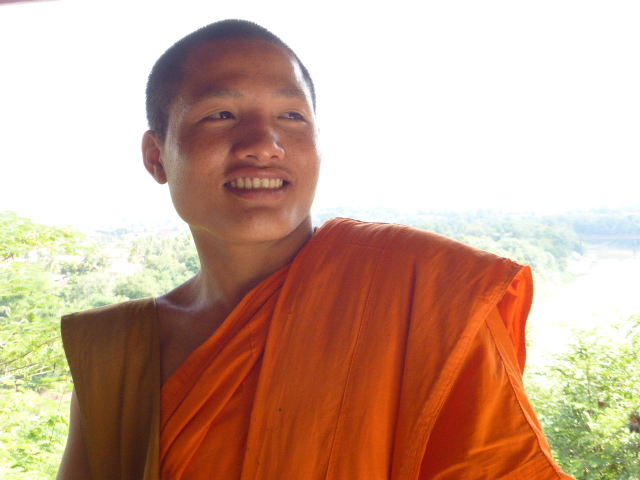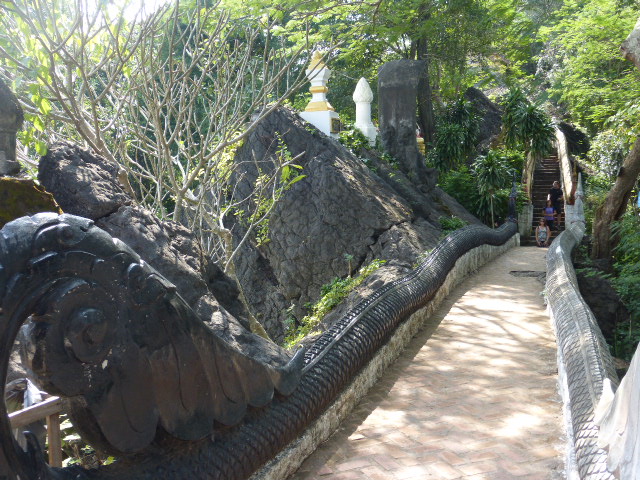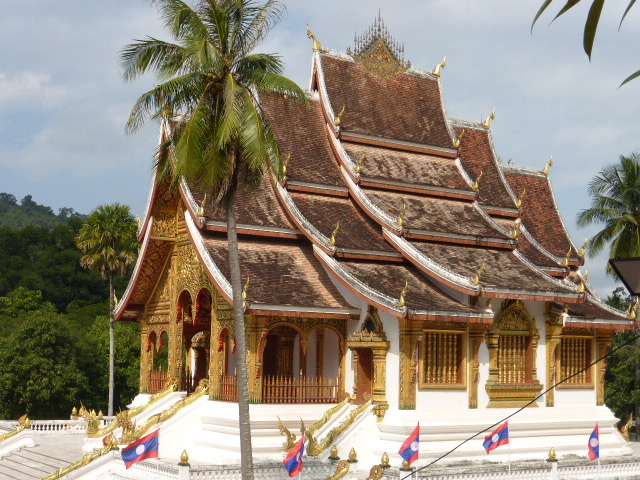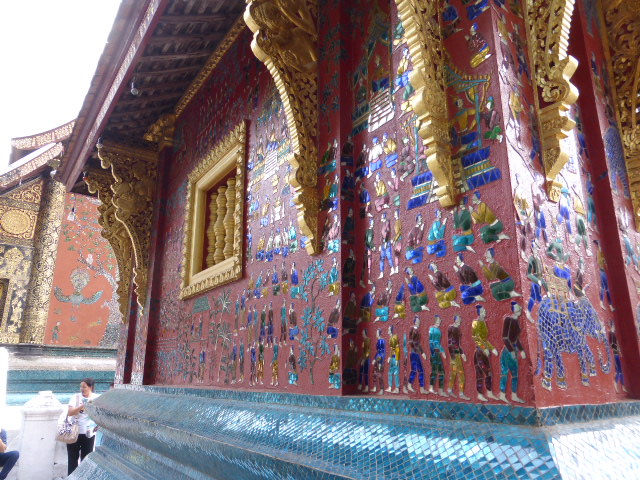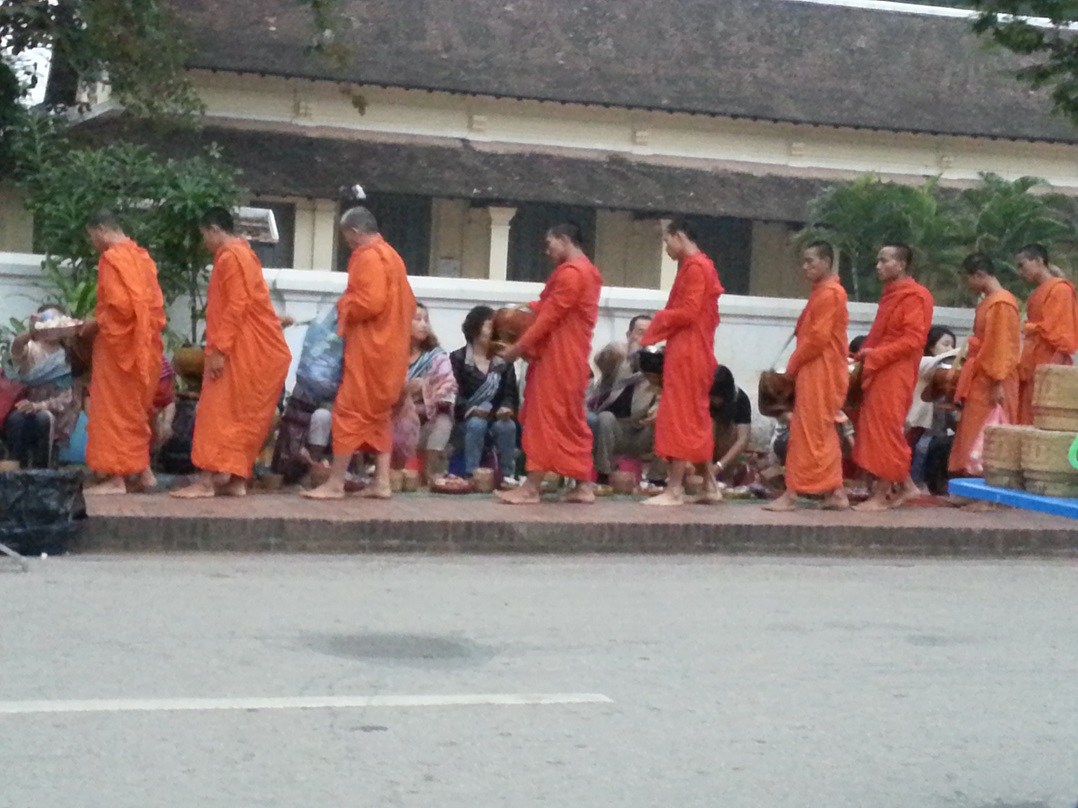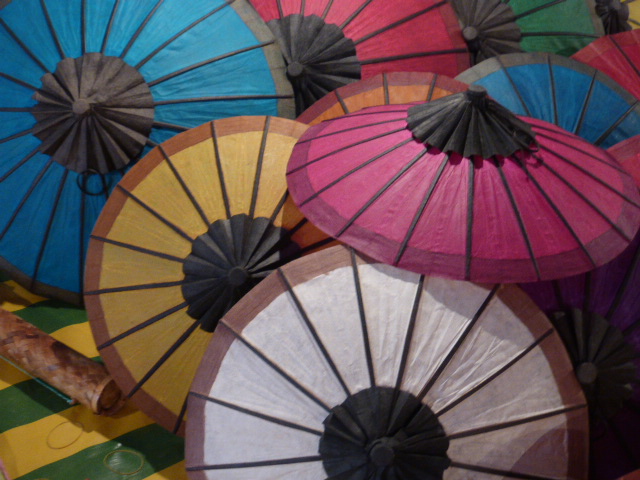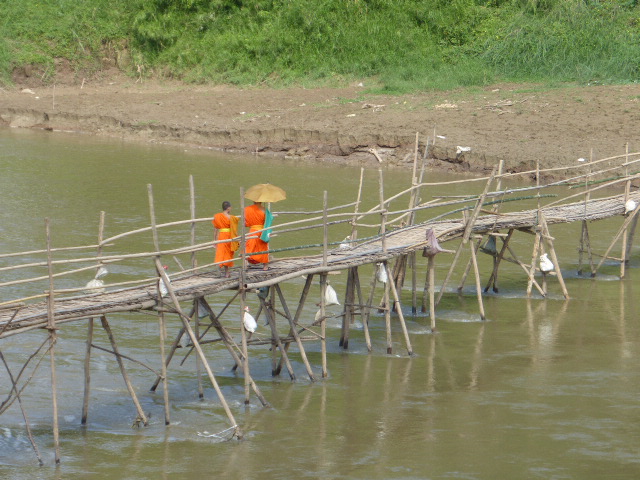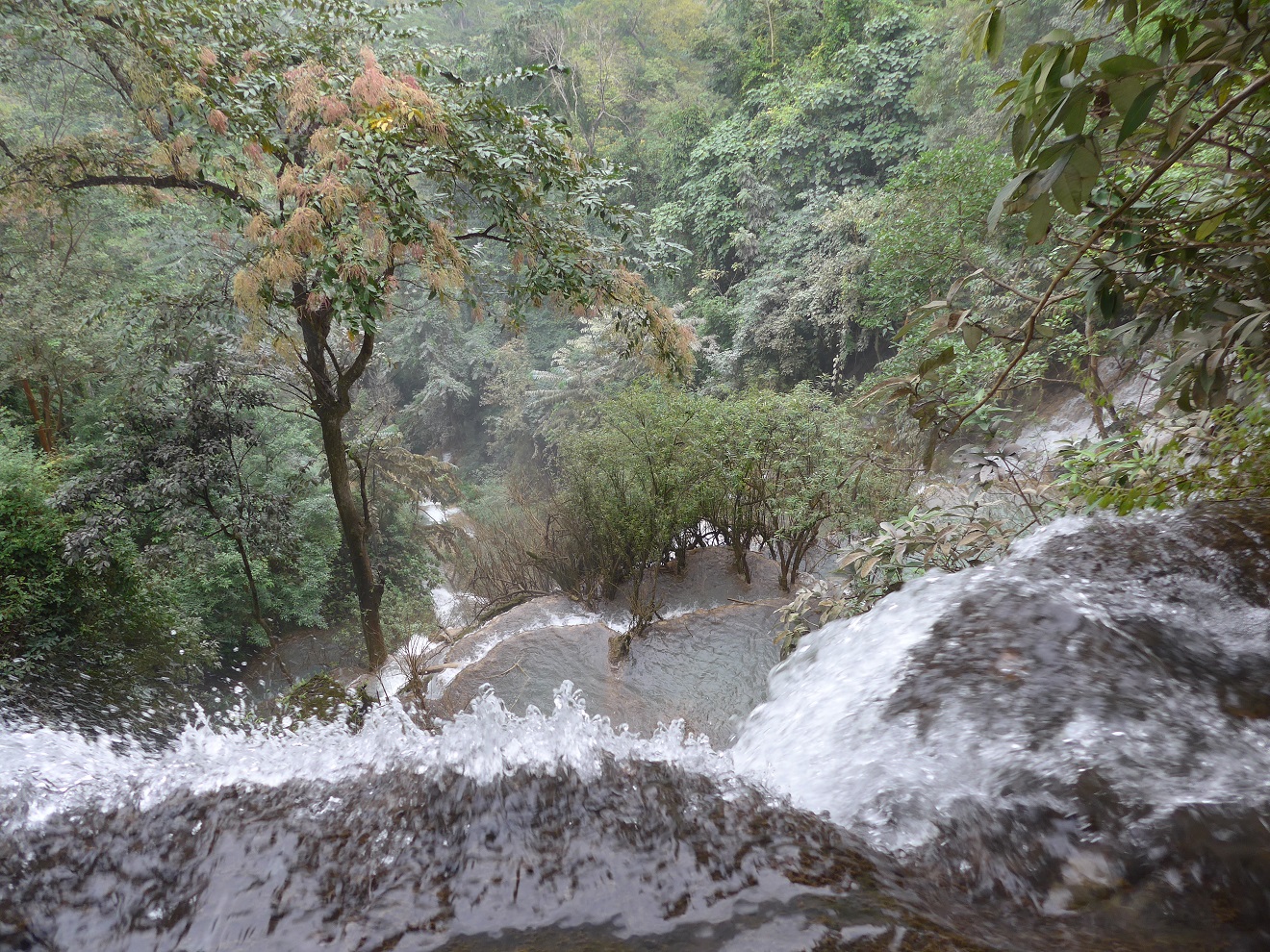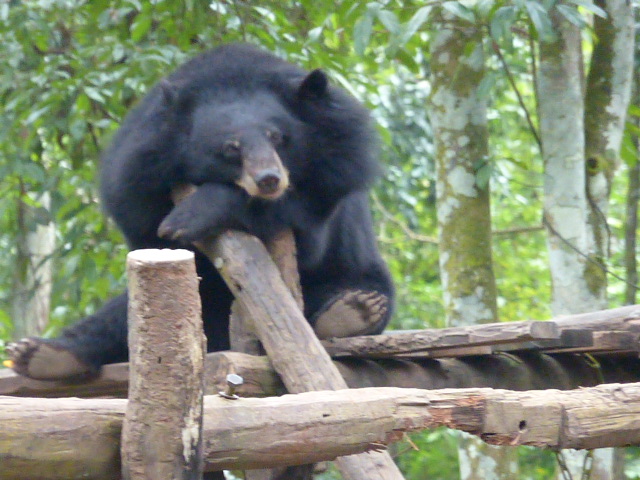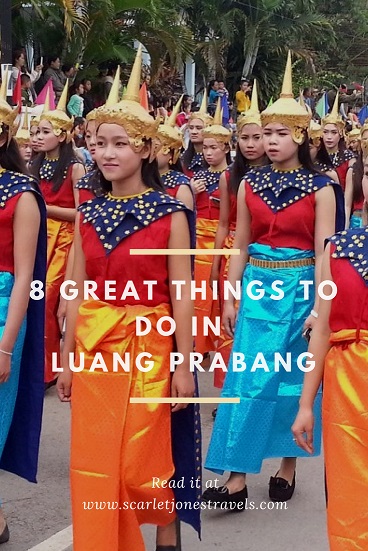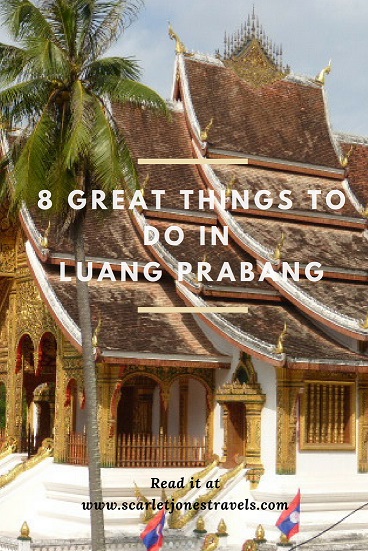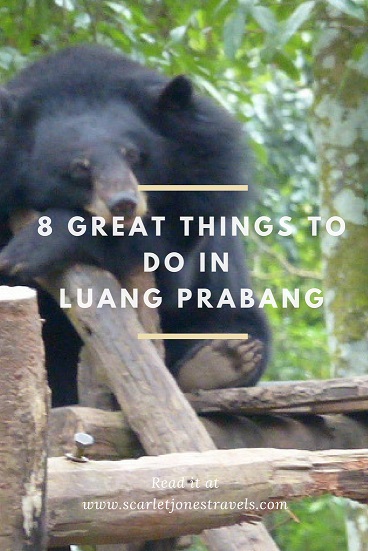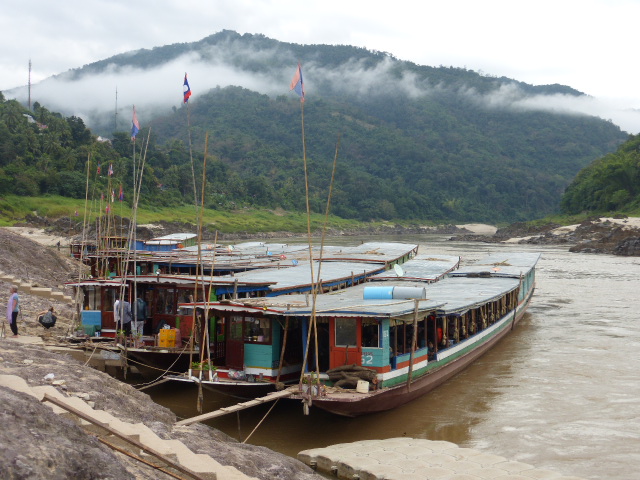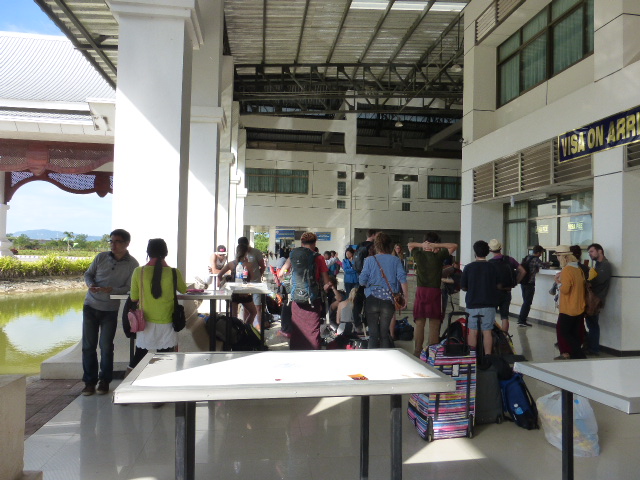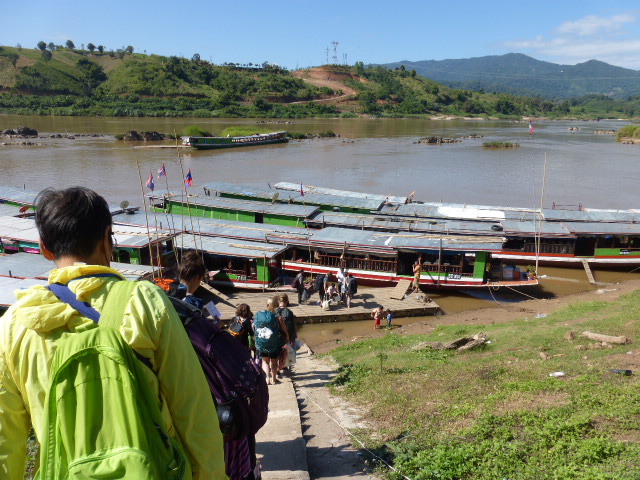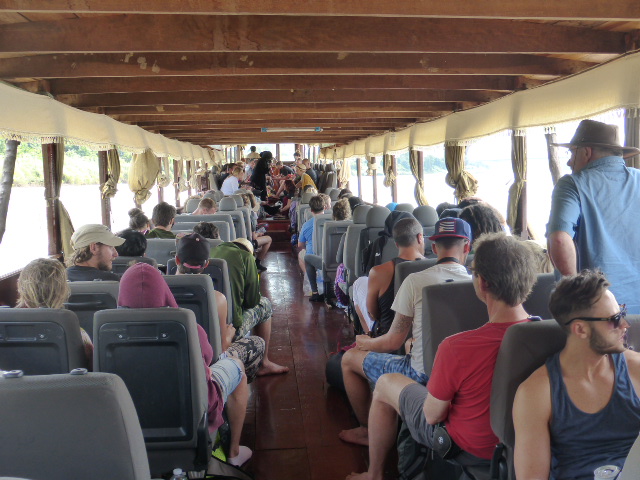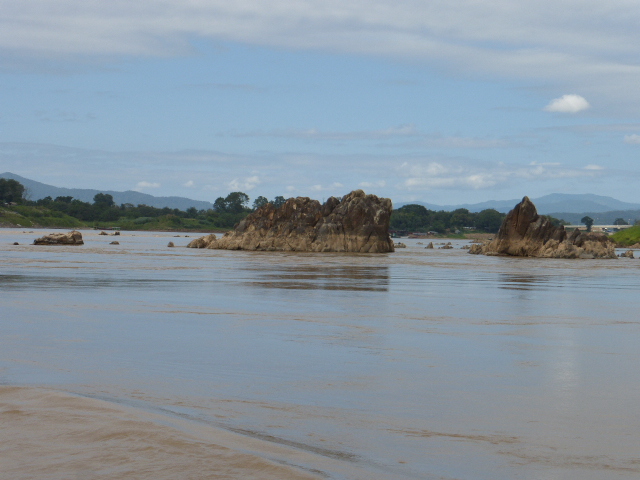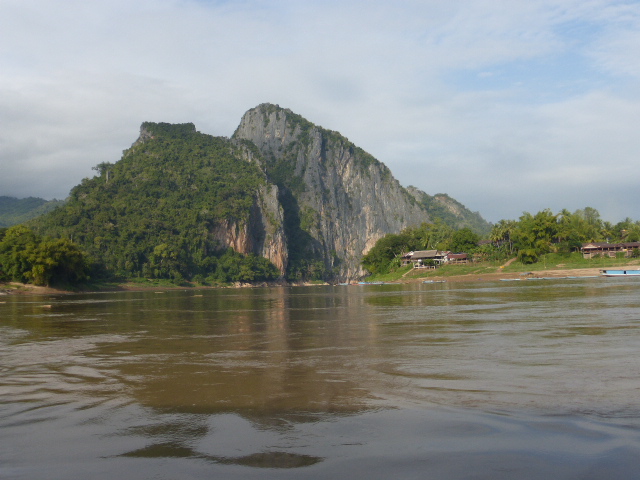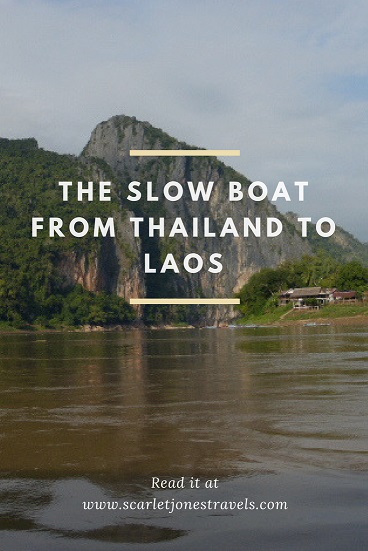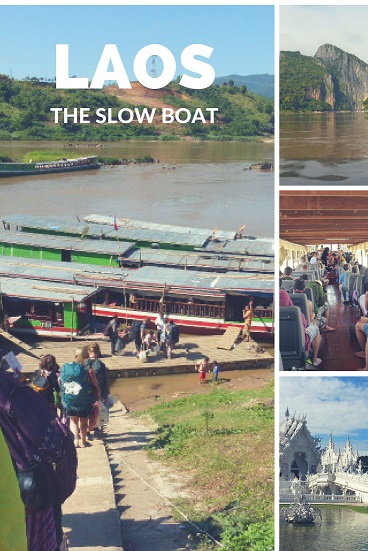
Luang Prabang to Nong Khiaw, Laos
After nearly a week in Luang Prabang we decided that it was time to move on. I was heading north into the mountains, together with my Polish friend Gosia and Marc from Catalunya.
[grwebform url=”https://app.getresponse.com/view_webform_v2.js?u=spPd&webforms_id=13182401″ css=”on” center=”off” center_margin=”200″/]
Simply getting there was eventful. The three of us were split up between a pair of minibuses and the backpacks strapped to the roof, then my driver decided to race everything else on the road, skidding around corners as I buried my head in a book and hoping that I wasn’t about to die (thanking the stars that I had travel insurance) …and then I had over an hour’s wait for the others at Nong Khiaw.
I spent my time watching the tuk-tuk drivers play boules in the field in front of the bus station whilst staring at the limestone mountains which towered overhead until Gosia and Marc finally caught up with me and we hiked the twenty minutes along the dusty lane and into the tiny town of Nong Kiaow.
This town (also called Muang Ngoi Mai) is REALLY sleepy. The main road crosses the river via a stone bridge which for 75% of the day has absolutely no traffic on it. A bevy of ‘restaurants’ cluster at one end of the bridge and little wooden cabins nestle among the trees on the riverbanks.
We knew that there was just one backpacker hostel in town and that beds were allocated on a first come first served basis so before looking at any of the log cabins we checked out Delilah’s. We struck gold as Delilah’s Hostel truly is a slice of home and there were just three beds left in the cosy dorm which we quickly claimed for our own. If you have missed out on Delilah’s check out other accomodation here at Agoda
Spectacular mountains
After checking in, Marc and I set off to climb a mountain. It took us almost an hour of very steep, hot and sweaty uphill climbing but boy was it worth it. We arrived at the lookout point an hour and a half before sunset.
We sat and cooled down on the little platform at the top and then we clambered around on the peak with the other travellers who had made it up there; whilst the sky turned to a delicate shade of apricot and the river changed colour to a romantic smoky blue far below us.
After coming down the mountain safely just before dark we were delighted to discover that they serve Amazing (with a capital ‘A’) cakes and desserts at Delilah’s. They also do rather good coffee too. Whilst there are plenty of places to stay in Nong Khiaw, Delilah’s is really the only place if you want to go anywhere social and it has does have a lovely atmosphere.
Delilah’s in Nong Khiaw
As I have already mentioned the desserts are always popular and the little wooden tables outside usually have plenty of people gathered around chatting; while inside big squoosy floor cushions and mats invite you to relax. A DVD is shown each evening on the TV (the social area is open and very popular with non-residents) and it has a wood burner for the colder nights and plenty of beer to drink.
The dorm is really cozy with a double bed in one corner and bunk-beds – each with its own privacy curtain, mozzie net and nice big lockers underneath for security. The whole building is an original (renovated) wooden house. Bathrooms have HOT showers and believe me, a hot shower in a backpackers’ hostel in Laos is a luxury.
Rural village life
After a comfortable night’s sleep Gosia, Marc and I hired bicycles and we set off to see the surrounding countryside. We pedalled along the main road passing through traditional villages of minority groups – some smiled and waved, others grabbed their children and dragged them inside hissing ‘Farang’ (foreigner) at us. For our part we didn’t stare, we didn’t rudely stick cameras in anybody’s face and we didn’t stop and peer into homes but I suspect that some travellers may have done so in the past and made people a little suspicious.
The majority of the homes were built of wood or woven bamboo or canes and as far as we could see, contained little furniture. Most had earth floors and women cooked over earthenware pots of burning wood and outside there were chillies, rice or peppers drying in the sun.
When the local school day ended, streams of children in their spotless white shirts pedalled their bikes along the road narrowly avoiding the huge trucks which rumbled through at breakneck speed on their way to construct the dam a few kilometres away.
These kids were far more friendly than some of their parents and were quick to yell ‘hello’ and ‘where you from’ at us and two cute little girls even ran over to present Gosia and I with some wild flowers.
On our way back to the town as dusk fell we came across the most rural rustic market that I have ever seen. Just a few wooden tables were set up under tarpaulins and the local ladies were selling a really poor selection of sad looking fruit and vegetables, some dodgy looking bread and …rats on sticks!
There was also the remains of a corpse that could have been anything. Sign language failed – but we understood that it came from the forest. If you can hazard a guess, please post your suggestion in the comments box at the end.
I always like to support a local market but we were hard pressed to find anything that looked like it was fresh but on a table in a corner we found some of those tiny bananas which had to do.
We stopped to watch a group of boys playing the traditional game that is played all around Laos. Played with a raffia ball it’s a mixture of keepy-upsy and volleyball, agilely played with the feet and head (no hands) and fascinating to watch. We also stumbled upon a cute little mountainside temple where the friendly monk spoke very good English and I arranged to return the following evening and listen to the prayers and the chanting.
The minority tribal people
After another comfortable sleep, the next day Marc left to go south and Gosia and myself went for a walk along the river bank where we knew there would be some minority tribe people living in their traditional villages. It turned out to be a VERY long walk under a VERY hot sun but we found the villages where people were luckily more friendly than the previous day and we also passed a very tired, sad looking elephant and its owner on their way back from working somewhere in the forest.
Stopping at what was to all intents and purposes a shop we were joined by a little old lady who was totally intrigued by us and after just a little persuading she accepted a drink from us. This is where I filmed my introductory video for the course – you can see it here – but what you can’t see is the little old lady opposite who was trying so hard to make me laugh.
After arriving back in the town, I went to the little temple. I sat quietly at the back while the monk prepared himself and then he began his chanting. For forty minutes I was mesmerised as he was joined by the younger novices and their voices ‘sang’ the prayers. In the peace of the mountains the chanting echoed around the temple raising the hairs on the back of my neck. I walked back to the hostel in the dark among houses where the women were all cooking their evening meals on coals outside the doors, and felt an incredible peace.
To accompany this series of articles on Laos, I have published a comprehensive 28 page travel itinerary of my month-long route around Laos. Simply enter your details in the box below to get your free guide.
[grwebform url=”https://app.getresponse.com/view_webform_v2.js?u=spPd&webforms_id=13109801″ css=”on” center=”off” center_margin=”200″/]The journey from Luang Prabang to Nong Khiaw
Buying a baby
That evening, I chatted to Hamps (Hamish) the owner of Delilah’s who has a fascinating history.
Hamps, a New Zealander, originally came to Laos in the year 2000 when roads were no more than dirt streets, and then he later returned in 2010 as a volunteer English teacher.
While working in Luang Prabang he was approached by Tiger Trails and asked to run branch of Tiger Trails in Nong Khiaw. After arriving in Nong Khiaw Hamps took over Delilah’s and completely transformed the building: repairing the balconies, the shutters and restoring the wood from which the building is constructed. One of the key attractions at Delilah’s has to be the bakery – all desserts and bread are homemade, as are the jams and chocolate.
Another attraction are the films that are shown each evening but also on many afternoons there is a showing of the documentary film ‘The Secret’ which always attracts a large audience. Delilah’s is a slice of home. [easyazon_link identifier=”1906030944″ locale=”UK” tag=”scajonblo0e-21″]If you want to watch The Secret you can buy it at this link[/easyazon_link]
But there is a darker side to Hamps’ history and one which obviously troubles him.
A few years ago, his then French girlfriend bought a baby from a hospital in Laos for $500.
When she and Hamps split up she left the baby with the then owner of the hostel. Although struggling with his own work Hamps continued to share the care of Mimi with the hostel owner but then found himself in a fight for custody when the ex-girlfriend decided to return. She attempted to remove Mimi to France, although as far as Hamps is aware they are currently living in Thailand with her boyfriend.
Hamps has since tracked down the baby’s birth mother. She gave her baby away to the hospital believing that the baby would have a better life, but here is the mystery that Hamps is trying to solve. Who authorised the sale of the baby? Was it the hospital acting as an official adoption agency or a member of staff acting independently and under the table?
Hamps obviously misses Mimi but he is not letting that stop him as he forges ahead with creating his welcoming hostel and working with the local guides at Tiger Trails.
Many things are alien to us as we travel and learn about different cultures and customs but things involving childeren are always hard to understand.
Can you relate to Hamps’ story?
I certainly can. I have been estranged from my own children for nearly eight years. Before I left my marriage I didn’t know any parent who had been separated involuntarily from their children thanks to the actions of the other parent, but now I know of many people; men and women of all ages and from all around the world who have had their contact cut.
These parents go through a process. Maybe in a different time frame or in a different order but they each feel despair, anger, sadness, hopelessness until finally there is some acceptance and it comes full circle to hope. My aim while I am travelling is to inspire other people who may be feeling stuck in a downward spiral and show them that there is light at the end of the tunnel. I do this through the stories that I write about the people who I meet or via my mindset coaching business and the Smash the Pumpkin Project.
I will leave you here in Nong Khiaw with two questions.
- Travel puts difficult things into perspective and can help you organise your thoughts easier.
How do you deal with the really bad stuff and move on?
2. What on earth is the animal that was on the table at the market? (I apologise if you are a vegetarian or a vegan or if you are eating your dinner while you read this article!)
Put your answers to one of both of these questions in the comments below – and if you haven’t already done so, sign up and receive updates and future articles and opinion pieces from my blog and website.
[grwebform url=”https://app.getresponse.com/view_webform_v2.js?u=spPd&webforms_id=13127101″ css=”on” center=”off” center_margin=”200″/]
Disclaimer: I received a discount off my stay at Delilah’s hostel; however this did not influence my article in any way – and all opinions are, as always, my own.
Scarlet Jones Travels is a participant in the Amazon Services LLC Associates Program, an affiliate advertising program designed to provide a means for sites to earn advertising fees by advertising and linking to Amazon.com
This post contains affiliate links and/or references to our advertisers. We may receive compensation when you click on or make a purchase using these links
